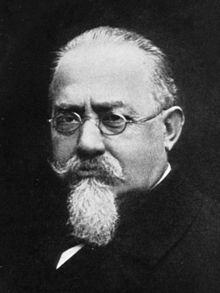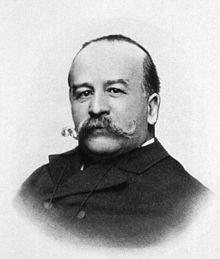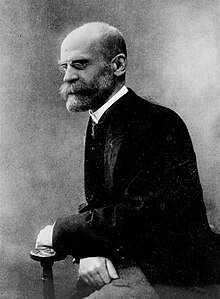criminology
Criminology (composed of the Latin crimen 'crime' and -logie from the Greek and Latin word -logia ; from ancient Greek λόγος lógos , ' word ', also: ' doctrine ') literally translated means doctrine of crime . Criminology makes use of various related sciences such as law and psychiatry , sociology and pedagogy , psychology , ethnology and anthropology , as well as, in the last few decades, economics to describe and examine the manifestations of crime .
In Germany, university criminology is largely affiliated with the law faculties. In Anglo-American and Scandinavian countries, on the other hand, criminologists are predominantly assigned to the social science departments.
Criminology is to be distinguished from criminology , the teaching of the means and methods of fighting crime.
History and currents in criminology
The systematic preoccupation with crime begins in the 18th century as part of the Enlightenment . The term criminology did not appear until the second half of the 19th century. According to Hans-Dieter Schwind , it is said to come from Paul Topinard , and there is evidence that it was first used by Raffaele Garofalo as the title of his work Criminologia , published in 1885 .
The classic school
The so-called “classical school” does not yet establish an independent subject of criminology . The discussion of crime does not take place from the point of view of experts, but from that of individual universal scholars . From their perspective, crime is an omnipresent temptation for all people. The question of why some people succumb to the crime and others do not is not addressed.
The main representative and founder of the “Classical School” is Cesare Beccaria . The Milan in 1764 published a pamphlet entitled Dei delitti e delle pene (German: Of the crimes and the penalties ), which was soon translated into French and German and Europe sparked a debate on criminal law and criminal policy. Beccaria's reasoning is based on the Enlightenment assumption that all people are equal and free. For the understanding of crime, it follows that in principle everyone is capable of committing a crime and there are no individual causes beyond free choice. This means that possible perpetrator-oriented explanations of delinquency are rejected. Beccaria names unreasonable legislation as the cause of crime, which increases the number of criminal acts instead of reducing them. As further causes, he names a corrupt jurisprudence, inadequately regulated criminal proceedings and the encouragement of denunciating through secret charges. Thus the causes of crime are laid out in the criminal justice system itself. In addition, he denounces the uselessness and injustice of the death penalty and torture in his writing.
According to Karl-Ludwig Kunz and Tobias Singelnstein , for the Beccaria-shaped “Classical School”, the necessity of a moderation of the penal force under the rule of law follows from considerations of usefulness. An "economic calculation of punishment" is followed, which is supposed to increase its effectiveness and social acceptance. It should no longer be punished excessively, but just as much as is sufficient to prevent crimes. That is the basis for a socio-technically determined, prevention-related and efficiency-oriented criminal law. This line of development was particularly followed by Jeremy Bentham in the context of British utilitarianism . In an effort to achieve the highest level of technological punishment efficiency, he proposed the Panopticon , a prison structure that enables total surveillance.
Bernd-Dieter Meier names the Englishman Samuel Romilly , who enforces the abolition of the death penalty for theft and begging, the English prison reformer John Howard and Paul Johann Anselm von Feuerbach , who also spoke out in favor of the abolition of the death penalty, as further initiators of the “Classical School” , enforced the abolition of torture and under whose influence the first modern penal code was created in Bavaria.
The positivist school
Criminology emerged as an independent field of science in the context of positivism in the 19th century . This is characterized by the assumption that the determining factors of human action cannot be derived from the freedom of choice, but that human action follows general laws (causes) that can be recognized by empirical science. What causes it is a matter of dispute in the positivist criminology of the 19th and 20th centuries. Three main directions emerged, the Italian (criminal anthropological) school, the French (criminal sociological) school and the Marburg school, which combines criminal anthropological and criminal sociological causes.
The Italian (criminal anthropological) school
The main representative of the school of criminal anthropology was the Italian physician Cesare Lombroso , who is widely regarded as the founder of criminology. Although his early theses are considered completely refuted, he was the first to develop his theoretical statements on the basis of extensive studies and based on a strictly empirical approach.
Lombroso believed to have found that offenders differ from other people in many physical and psychological abnormalities. He interpreted this as an expression of the atavistic, degenerate level of development of the criminals. This state of development prevents them from adapting to the rules of civilized society. These empirical findings were later not confirmed. They also suffered from the one-sidedness of the research interest, social causes did not give Lombroso any importance in his early work. Only later did he admit that only about a third of the offenders were “born criminals” and that social factors were at work in the remaining cases. Even Enrico Ferri , who initially Lombroso's initial thesis stated, sat down later for the consideration of social factors. Raffaele Garofalo , who gave criminology its name, advocated the thesis that those who commit the “natural crime” are a special anthropological type suffering from a lack of unselfish sensibility.
As "natural crimes" Garofalo only defined actions that run counter to elementary human impulses. They are the real crimes and therefore the subject of criminology. They form the actual area of crime, only they are the subject of criminology.
The French (criminal sociology) school
The French school of criminology rejected the criminal anthropological approach and focused on the societal conditions in which crime occurred. Important impulses for this point of view came from the crime statistics data collections being created in many European countries . André-Michel Guerry and Adolphe Quetelet were pioneers of crime statistics ; they called their research discipline moral statistics .
Leading theorists of the French school were Alexandre Lacassagne and Gabriel Tarde . Lacassagne argued that the milieu is the breeding ground for crime . He wrote the sentence: "Every society has the criminals it deserves." Tarde saw the main cause of crime in imitation and postulated that a criminal could only imitate what others had shown him. From this he concluded: "Everyone is guilty with the exception of the criminal."
According to Kunz / Singelnstein, these early studies formulated program approaches rather than testable assumptions. They did not pursue any specific crime preventive goals, but wanted to promote private charitable efforts by abstinence associations and reform associations as well as state aid for the disadvantaged.
Émile Durkheim , who founded the sociology of crime at the end of the 19th century, has a special role . Unlike the positivist criminologists, he did not ask about the causes of the crime as individual behavior. He looked at the role of crime in society and the circumstances that influenced the development of societal crime rates. For him the crime was not a socio-pathological phenomenon to be combated, but a normal element of modern industrial society, which was explained by the social structure. A normal and necessary phenomenon is crime for every society, explains Durkheim in his work The rules of the sociological method ( Les règles de la méthode sociologique ) published in 1895 , because there is no society in which there is no crime. Crime is normal because there are always people who violate norms and commit criminal acts. It is necessary because it contributes to strengthening and further developing the collective development of standards.
The fact that there are crimes in every society needs no explanation for Durkheim. However, significant changes in crime rates would need to be analyzed. A society falls into the state of anomie when changes in the social structure, for example through modernization processes, lead to a collapse of legal and social norms. Durkheim developed his thoughts on anomie in 1897 in his work on suicide ( Le suicide ). Later theorists, especially the North American criminology and there Robert K. Merton , transferred his considerations to the explanation of the crime.
20th century to the present
The inherent explanatory approaches established by Lombroso and his school were continued in the 20th century through adoption and twin research , as well as the less popular so-called " phosphate theory " (increased readiness to be aggressive due to excessive consumption of phosphate- containing meat products). In addition, the existence of a so-called murderer chromosome was temporarily assumed (redundant Y chromosome or XYY syndrome ), the causality of which, however, for the commission of crimes could be scientifically refuted.
At the beginning of the 20th century, voices increasingly prevailed who suspected the causes of the crime not only to be in human beings, but also included the environment as the cause. In this context, the so-called system-environment formula developed by Franz von Liszt , according to which he described the crime as the result of the perpetrator's individuality and the external influences surrounding him at the time of the crime. During the time of National Socialism , the theories inherent in the system gained in importance, which was reflected, for example, in the extension of criminal sanctions to family members of the offender (see also family liability ).
Nowadays there are a number of very different explanations. These can be roughly divided into:
- perpetrator-oriented theories
- society-oriented theories
- multifactorial approaches (for the individual theories see also theories of crime )
In critical criminology , in accordance with the ambiguity of the Latin origin of the term crimen , which can mean both accusation and crime, under "crime" the entirety of the actions and interactions between the institutions responsible for lawmaking and enforcement on the one hand and those responsible for breaking the law on the one hand on the other hand, individuals affected by legal compliance are understood.
Representatives of the emergent since the 1950s Labeling Approaches , labeling theory ' (eg in Germany. B. Fritz Sack and Peter-Alexis Albrecht ) believe that crime ubiquitous (ie widespread) was, and only certain sections of society by the Legislature as well as the law enforcement authorities would be "selected out" - and thus labeled - as criminals.
In deliberate differentiation from etiologically oriented criminology, the supporters of the labeling approach do not explain the origin of crime by attributing it causally to causes in the person of the perpetrator or in the social structure. According to this view, crime is rather the result of a societal process of attribution. Parts of the labeling approach can be assigned to (criminal) abolitionism (a trend that calls for the abolition of any kind of deprivation of liberty).
Area of responsibility and working method
The concept of criminology is to be distinguished from the concept of criminalistics . Both sciences can be viewed as auxiliary to the other. While the primary goal of criminology is the abstract (i.e. not related to a specific case) acquisition of knowledge about the causes and manifestations of crime, criminology deals with the concrete - practice-related - questions of prevention, combating and solving crimes.
Central considerations in criminology are crime , the criminal , the crime victim, and crime control.
Criminology includes in particular the theories of crime (including the control theories , which investigate the question of why people behave in conformity - i.e. do not become criminals); Criminology must continue to include the area of the meaningfulness of punishment .
If one regards crime as a mass phenomenon, then criminology also uses the well-known crime statistics . These then also have a considerable share in the practice of criminal policy , which can be disseminated better with figures that are easy to convey than indications of complicated investigations. Central terms here are the brightfield and the darkfield . The limited informative value of the statistics is always problematic in this context.
Victimology
Victimology is the teaching of victims through crime.
See also
- Criminologist (including information on training courses)
- List of German-speaking criminologists
literature
Textbooks and general presentations
- Peter-Alexis Albrecht : Criminology. A foundation for criminal law . 4th edition. Beck, Munich 2010, ISBN 978-3-406-60007-4 .
- Britta Bannenberg , Dieter Rössner : Crime in Germany . Beck, Munich 2005, ISBN 3-406-50884-7 .
- Michael Bock : Criminology . 5th edition. Vahlen, Munich 2019, ISBN 978-3-8006-5916-6 .
- Ulrich Eisenberg and Ralf Kölbel : Criminology . 7th edition. Mohr Siebeck, Tübingen 2017, ISBN 978-3-16-153013-5 .
- Hans Göppinger , Michael Bock (Ed.): Criminology . 6th edition. Munich 2008, ISBN 978-3-406-55509-1 .
- Günther Kaiser : Criminology. A textbook . 3. Edition. Müller, Heidelberg 1996, ISBN 3-8114-6096-X .
- Günther Kaiser, Hans-Jürgen Kerner , Fritz Sack , Hartmut Schellhoss (eds.): Small criminological dictionary . 3. Edition. CF Müller, Heidelberg 1993, ISBN 3-8252-1274-2 .
- Karl-Ludwig Kunz and Tobias Singelnstein : Criminology. A foundation . 7th edition. Haupt Verlag, Bern 2016, ISBN 978-3-8252-4683-9 .
- Bernd-Dieter Meier : Criminology . 5th edition. Beck, Munich 2016, ISBN 978-3-406-69580-3 .
- Frank Neubacher : Criminology . 3. Edition. Nomos, Baden-Baden 2017, ISBN 978-3-8487-3036-0 .
- Hans-Dieter Schwind : Criminology and criminal policy. A practice-oriented introduction with examples . 23rd edition. Kriminalistik Verlag, Heidelberg 2016, ISBN 978-3-7832-0047-8 .
History of criminology
- Imanuel Baumann: On the trail of crime. A history of criminology and criminal policy in Germany, 1880 to 1980 . Wallstein, Göttingen 2006, ISBN 3-8353-0008-3 .
- Peter Becker: Corruption and Degeneration. A History of 19th Century Criminology as Discourse and Practice . Vandenhoeck & Ruprecht, Göttingen 2002, ISBN 3-525-35172-0 .
- Silviana Galassi: Criminology in the German Empire. History of a broken scientification . Franz Steiner, Stuttgart 2004, ISBN 3-515-08352-9 .
Web links
- Criminology Lexicon Online
- Links to sources of criminal statistics and criminological information - Konstanz inventory
- Link collection criminology (University of Tübingen)
- KrimDok , literature database (University of Tübingen)
Individual evidence
- ↑ Hans-Dieter Schwind : Criminology and criminal policy. A practice-oriented introduction with examples . 23rd edition, Kriminalistik-Verlag, Heidelberg 2016, ISBN = 978-3-7832-0047-8. P. 99.
- ^ A b c Karl-Ludwig Kunz and Tobias Singelnstein : Criminology. A foundation . 7th edition, Haupt Verlag, Bern 2016, ISBN = 978-3-8252-4683-9, p. 37.
- ^ Karl-Ludwig Kunz and Tobias Singelnstein: Criminology. A foundation . 7th edition, Haupt Verlag, Bern 2016, p. 35 f.
- ↑ Bernd-Dieter Meier : Criminology . 5th edition, CH Beck, Munich 2016, ISBN 978-3-406-69580-3 , p. 14.
- ↑ a b Bernd-Dieter Meier: Criminology . 5th edition, CH Beck, p. 17.
- ↑ Michael Bock : Criminology. 5th edition, Vahlen, Munich 2019, ISBN ISBN = 978-3-8006-5916-6, p. 21.
- ↑ a b c d e Bernd-Dieter Meier: Criminology . 5th edition, CH Beck, p. 18.
- ^ Karl-Ludwig Kunz and Tobias Singelnstein: Criminology. A foundation . 7th edition, Haupt Verlag, Bern 2016, p. 38.
- ↑ Bernd-Dieter Meier: Criminology . 5th edition, CH Beck, p. 19.



